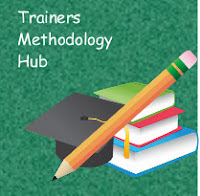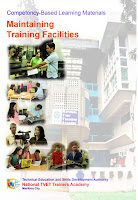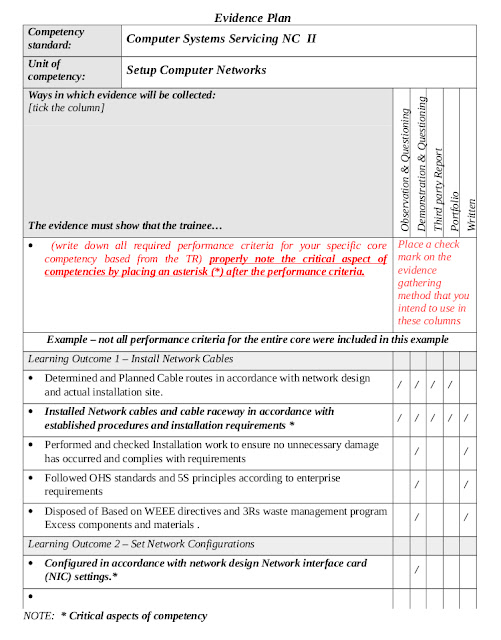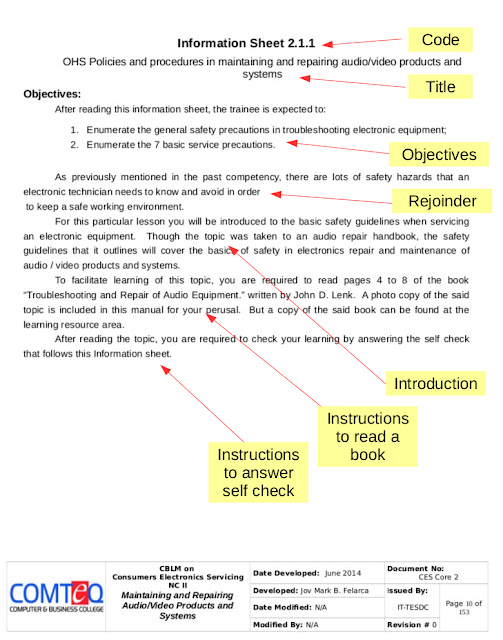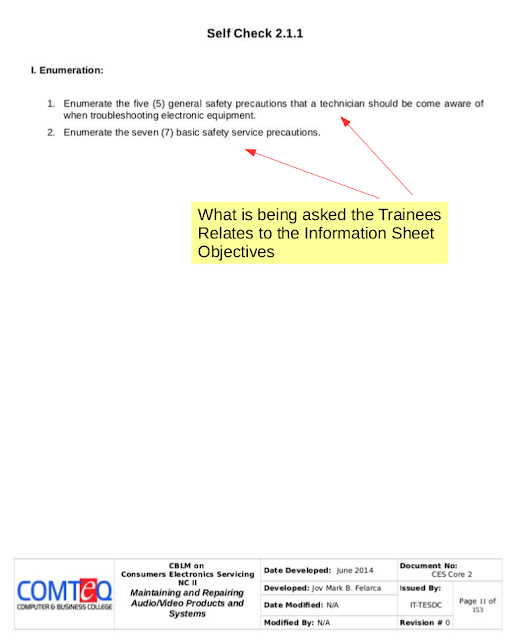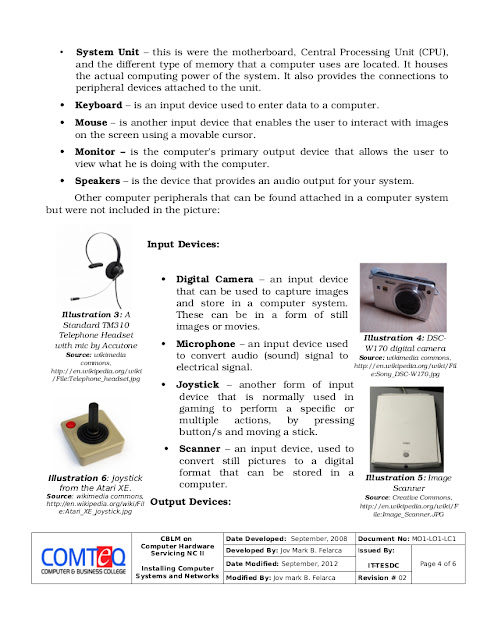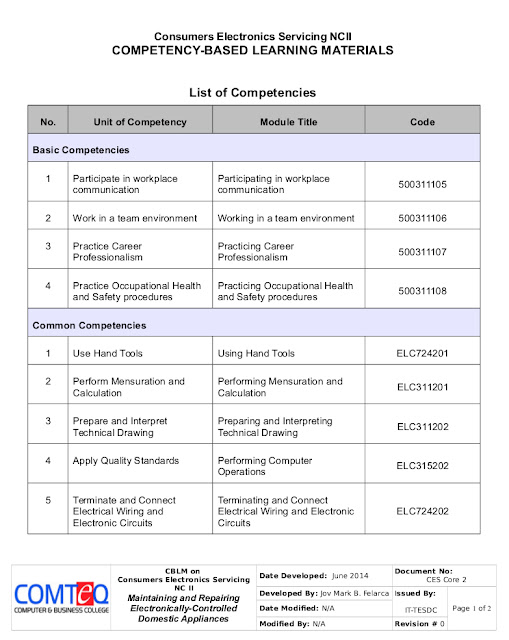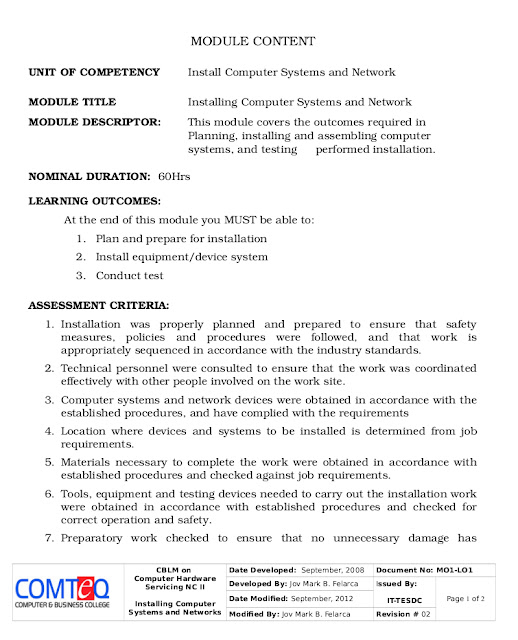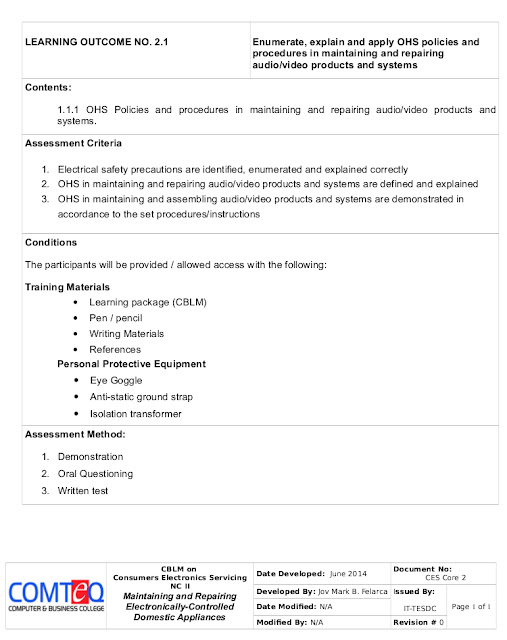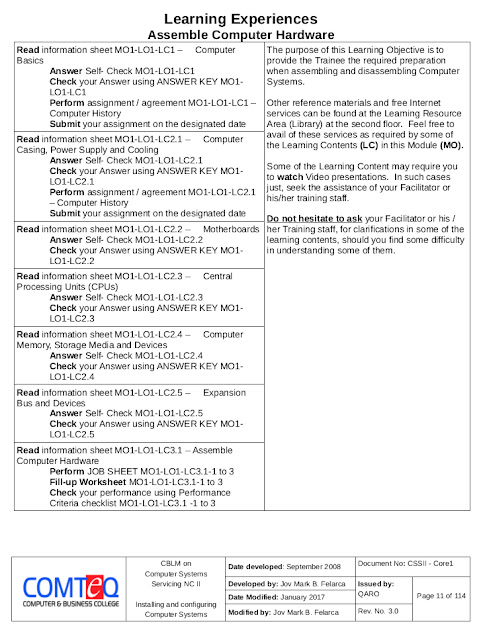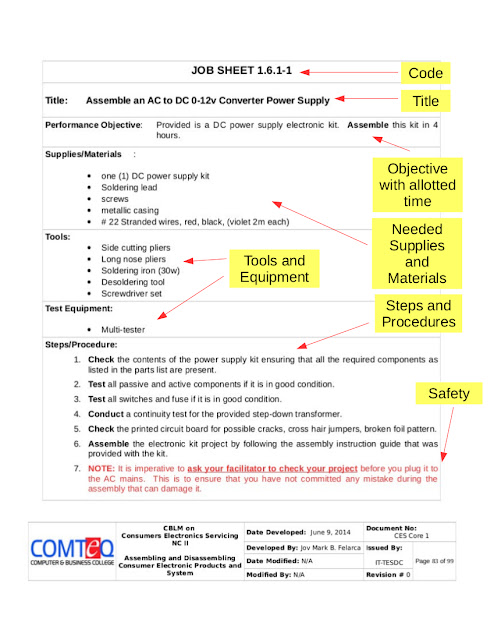Explaining Session Plan
It has been my observation since I became a Trainers Methodology Level 1 (TM-1) Facilitator, of the kind of difficulty that a TM-1 Trainee tends to encounter when developing their respective Session Plan.
For this blog , what I will do is to walk you through on how I developed my Session plan that I utilized in my TM-1 portfolio document.
What you will need
The sample that I will be using is one of the old session plan that I made way back in 2013 from my old TVET Qualification Consumers Electronics Servicing NC II (CES NC II). To better follow the discussion and samples that I will be providing, it is highly recommended that you
download a copy of this Sample Session Plan so that you can have a working example and reference as you develop your own.
This document is a copy left material with attribution, feel free to distribute to anyone provided that you agree with these terms and condition:
- The Session Plan was developed froms the old CES NC II Training Regulations (TR) and has already been superseded by a newer Training Regulations, Electronic Product Assembly and Servicing NC II (EPAS NC II).
- That the sample material is provided as is and with no guarantee of anything.
- That the Sample Session plan will only be used as a reference for the development of your own session plan.
With all of this in mind, before we proceed with this walk through you need to prepare the following, a copy of the:
- Plan Training Session-Competency Based Learning Materials (PTS-CBLM);
- Training Regulations (TR), for your respective qualification, (if you do not have a copy of your respective TR, you can download it from the provided links on this blog); and
- Session Plan Template (if you do not have a copy of the Session plan template, just click on the provided link on this blog).
Aside from this, make sure that you have already read this previous blog; a lot your spare time; and an Internet connection of sufficient speed.
With all things properly set-up, let us proceed to our walk through discussion.
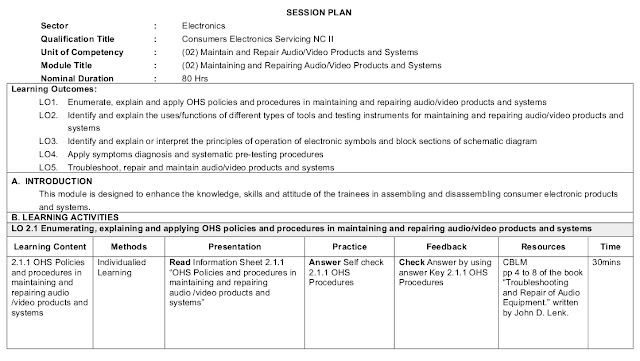 |
| Figure 1. Sample CES NC II Session Plan page 1 |
Sample Session Plan page 1, (please refer to figure 1)
Sector: Electronics - indicated sector was taken from the front page of the Training Regulations. (self explanatory)
Qualification Title: Consumers Electronics Servicing NC II - the title of my Qualification. (self explanatory)
Unit of Competency: (02) Maintain and Repair Audio/Video Products and Systems - Core Number 2, as referred to by (02) the second Core Competency of my Qualification as stated in the TR. The numbering of Core competency is helpful for properly indicating the needed codes of your content topics, Info sheets, task/job/operation sheets as I will explain later as we move forward on this walk through.
Module Title: (02) Maintaining and Repairing Audio/Video Products and Systems - why with the "ing" refer to previous blog or to the PTS-CBLM.
Nominal Duration: 80 hrs - the estimated needed number of hours to complete this Core Competency, most of the time can be found in a fully developed Competency Based Curriculum (CBC).
Learning Outcomes: - these are referred to as Elements under the TR, but referred to as Learning Outcomes in CBC. For this particular part, list down all the Elements or the Learning Outcomes of your respective Core Competency.
Introduction - the unit descriptor of the competency in the TR.
The Learning Outcome (LO) - worth noting is that the LO was placed above the learning activities, this is so in order to remind the Trainer that all Learning Activities should be designed in such a way that it will meet the desired Learning Outcome.
Learning Activities - this part of the CBLM is where most of the problem emanates and where most of my explanation will focus.
Let's start with the Learning Contents
Most of the problem in this area arises in regards to where a Trainer should get his/her respective topic. this is because what the TR simply provides are mere suggestions of possible topics that a trainee must learn to achieve the desired outcome. In regards as to how the trainee is to learn this, it always falls back to the TVET institution who has decided to offer the TVET Qualification. Thus, the importance of having a fully developed CBC.
The Competency Based Curriculum (CBC) is a reflection of how a Technical-Vocational Education and Training (TVET) Institution intends to offer a qualification based on its Thrust, Mission, Vision and Objective. This is so because, a training institution is given the academic freedom to determine what to teach, who to teach and how to teach, which is reflected on how your Institution developed the CBC.
Thus, you the Trainer whose services are commissioned by your respective Institution is oblige to deliver your Training based on what your institution requires which is reflected in the CBC.
In some cases however, even the CBC that was developed by an Institution might not reflect what you really believe is required in order to properly train your Students.
When this happens, you whose expertise are tapped to teach the qualification must ensure that whatever you decide to include as a topic does not deviate from what your Institution wanted and at the end of the day the desired outcome is achieved.
With this, any title can be used in determining the learning content, so long that it does not deviate from the learning objectives.
Performance Criteria as a title for a content
Personally speaking, i do not recommend the usage of the the Performance Criteria as reflected in the TR as a content title.
This is because Performance Criteria pertains to what the Trainee must learn to perform, thus when you use Performance criteria as a title for a content there is a tendency to simply focus on the skills development and might disregard the importance of Knowledge and attitude that you need to develop with the student to achieve the desired competency.
What I suggest though is for you to use Performance Criteria as an one your objectives in selecting the right contents for your topics.
Referring back to the sample session plan,
Content title - 2.1.1 OHS Policies and procedures in maintaining and repairing audio /video products and systems.
Note the numerical numbering that I used (2.1.1), what does it mean? The number two (2) refers to this content as content for Core Competency two.
Number one (1) refers to this content as content for Learning Outcome number one, and the last number, one, refers to it as content number one.
In summary it simply means, first content for learning outcome number one of core competency two.
The content title - it was derived from the Learning Outcome itself.
The methods that I had chosen for this Topic is individualized Learning. For the Presentation, the Trainees are require to read an Information Sheet. For their Practice, the Trainees are to answer a self-check, while for the immediate Feedback they are to check their answers using an answer key.
Resources - there are two sets of resources that the candidates will use, one is the Competency Based Learning Material, while the other is a reference book with the page, title and the author of the book was listed.
Time - the nominal time for this single activity is 30mins.
 |
| Figure 2. Page 2 of Sample CES NCII Session Plan. |
Figure 2. Sample Session Plan page 2
Referring to figure 2, worth noting is that there are two methods that I have selected to deliver this topic, first, was individualized learning, second was demonstration.
For the Presentation, the Trainer will be the one to perform the Demonstration, after the demonstration, the Trainees are to practice by performing a task, after performing the task, the Trainees are to check their performance using a performance criteria checklist to get the immediate feed back.
The required resources for the performance are listed, and the estimated time for each performance activity is 1hr. Since the Trainees are required to practice the task five times, the total time that this activity will take is five hours.
To summarized, content 2.1.1 will be be delivered using individualized learning and demonstration, to practice, the Trainees are required to answer some questions, and to perform five different task. The nominal number of hours to deliver this content under Learning Outcome number one is five and a half hours (5.5Hrs)
Well thats it, with this example, I hope that i had given enough explanation that would give you further understanding on the proper flow of a learning activity in a given content and start developing your Session more easily.
Should you have further questions, feel free to comment below.
Cheers!
